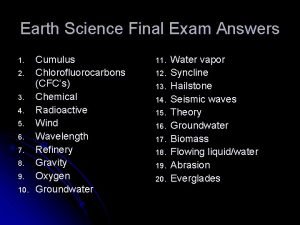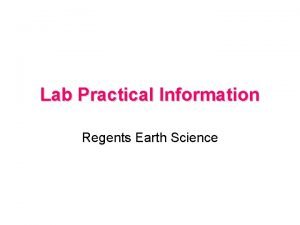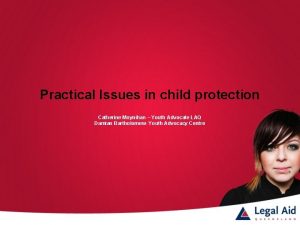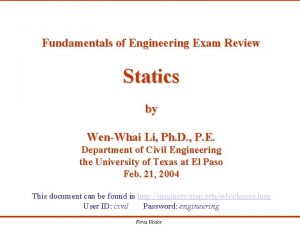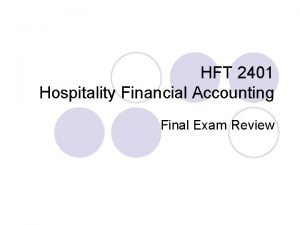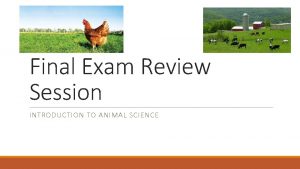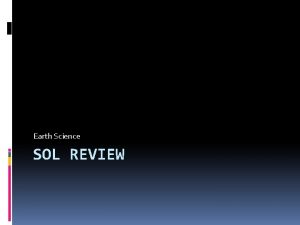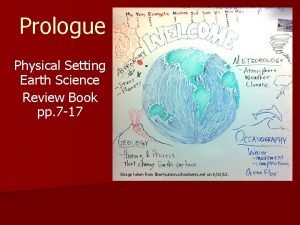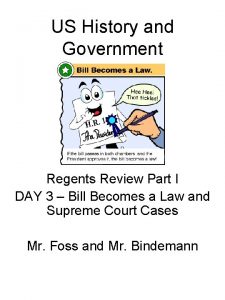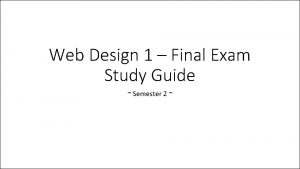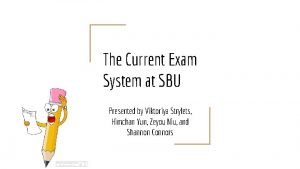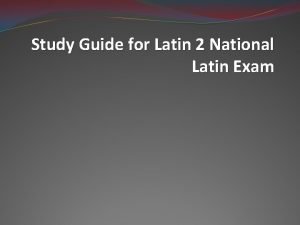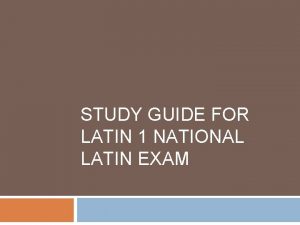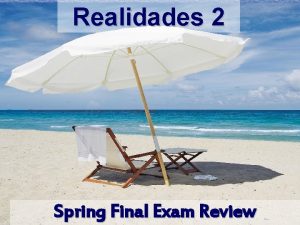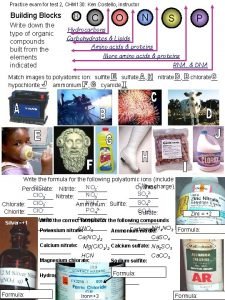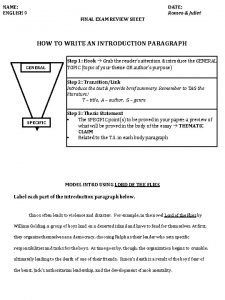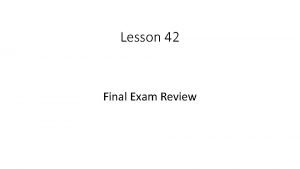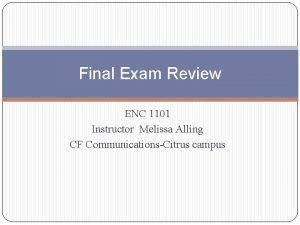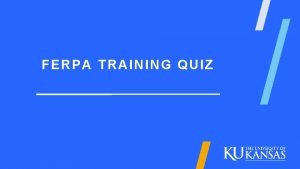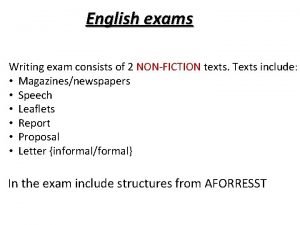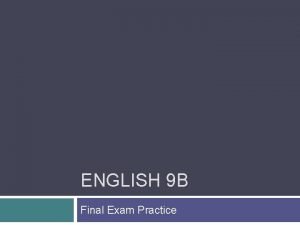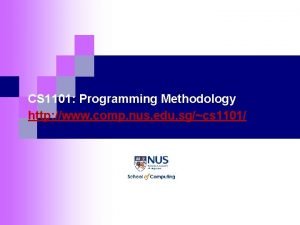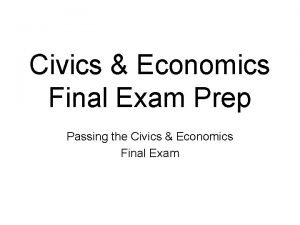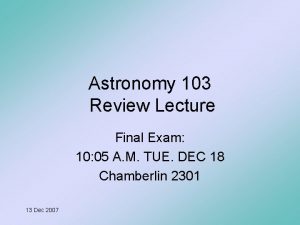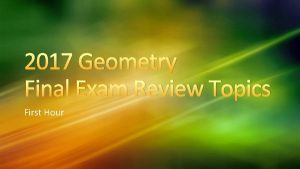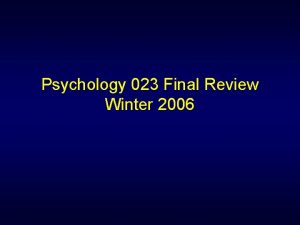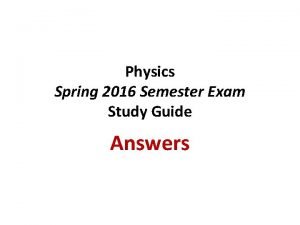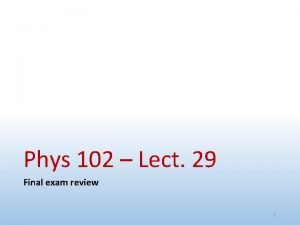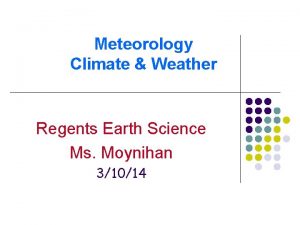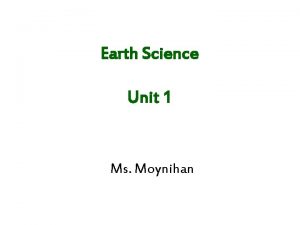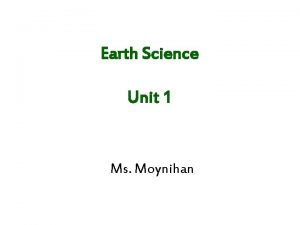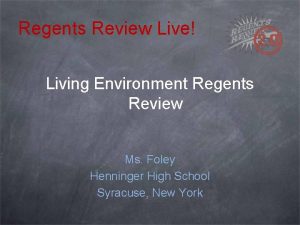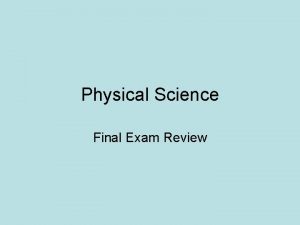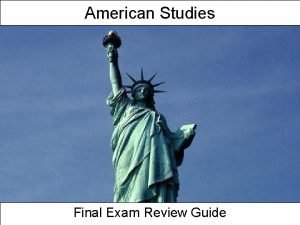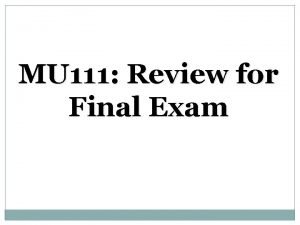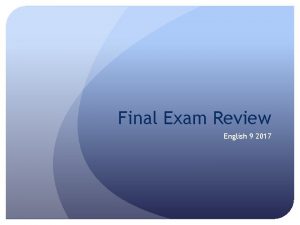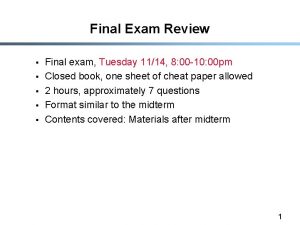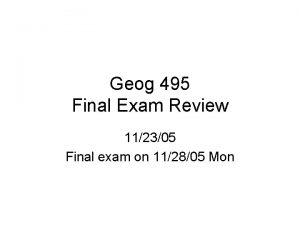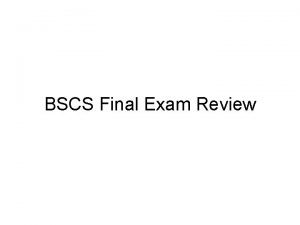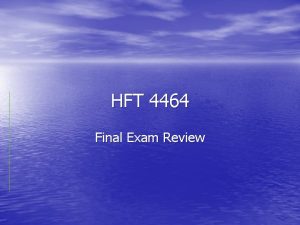Final Exam Review Regents Earth Science Ms Moynihan










































































- Slides: 74

Final Exam Review Regents Earth Science Ms. Moynihan 6/1/15

1. How many stations do you need seismographic data from to locate the epicenter of an earthquake?

* Every Tuesday & Thursday after school A 173 w/ Ms. Moynihan A 347 w/ Mrs. Dooher 3 PM – 3: 55 PM Starting Tues. May 26 th – June 11 th

* Part D Lab Practical ØThursday & Friday, June 11 th & 12 th In Class Earth Science Written Exam Parts A, B, C ØFriday, June 19 th 8: 30 AM

3 Lab Stations: 1. Identify 2 rocks as igneous, sedimentary or metamorphic. Identify 4 characteristics of a mineral sample. (7 points) 2. Identify the location of an epicenter, using ESRT page 11. (4 points) 3. Draw an elliptical orbit, calculate its eccentricity. Compare its eccentricity to that of a planet. (4 points)

*Igneous ‐ Contains crystals – gas pockets/vesicular ‐ glassy *Sedimentary ‐Contains fossils ‐conglomerate ‐ Contains pebbles/visible fragments *Metamorphic ‐ banding/layering of minerals ‐ metal‐like reflective crystals

q. P wave arrival time: _____ q. S wave arrival time: _____ q. Difference in arrival time: _____ min ____ sec Use ESRT page 11 q. Distance to the epicenter ____ km Draw the circle for _____ km For station Z, using the compass. q. Place an “X” where the Epicenter is located.

Take Supplies: 1. 1 board, Styrofoam side DOWN 2. 2 push pins 3. Metric Ruler 4. Pencil (if you don’t have one) 5. String 6. Calculator (if you don’t have one)

* Foci X X foci Major Axis

Fossils that can identify specific geological bedrock layers. Index Fossils are: ØWidespread ØAbundant ØLive in a short period of time


Rock like structures formed from the remains of cyanobacteria and precipitation of minerals.

Strata – A horizontal layer of material, especially one of several parallel layers arranged one on top of another. v. A bed or layer of sedimentary rock having approximately the same composition throughout.



v. This principle states that layers of sediment are originally deposited horizontally under the action of gravity. v. The principle is important to the analysis of folded and tilted strata.

v. Sedimentary layers are deposited in a time sequence, with the oldest on the bottom and the youngest on the top.

A geological fold occurs when one or a stack of originally flat surfaces are bent or curved as a result of permanent deformation due to stress or pressure.



Tilting (and folding) of strata is the result of tectonic movement ‐ most commonly caused by forces related to mountain building.



‐a radiometric dating method that uses (14 C) to determine the age of carbonaceous materials. ‐ One of the frequent uses of the technique is to date organic remains from archaeological sites up to about 60, 000 years ago. ‐Plants fix atmospheric carbon during photosynthesis, so the level of 14 C in plants and animals when they die approximately equals the level of 14 C in the atmosphere at that time.

‐However, it decreases thereafter from radioactive decay, allowing the date of death or fixation to be estimated.

* Half Life ‐ is the amount of time required for a quantity to fall to half its value as measured at the beginning of the time period. Most often used within the context of nuclear physics. It is the time required for half of the unstable, radioactive atoms in a sample to undergo radioactive decay.

* Uranium‐ 238, the most prevalent isotope in uranium ore, has a half‐life of about 4. 5 billion years; That is, half the atoms in any sample will decay in that amount of time.

* *Sample Problem: 1. Given the ½ life of 14 carbon, how much of a 100 g sample would be converted to 14 N: a) After 11, 400 years? a) After 17, 100 years?

Used to demonstrate that the Earth “spins” or rotates about its axis once every 24 hours! http: //www. calacademy. org/products/pendulum/page 2. htm

* 1) Complete any missing labs 2) Geological History of NY State 3) Review for Regents Exam - Study Note sheets - Do practice problems 4) Complete Any Extra Credit Assignments

Regents Earth Science Exam Review Ms. Moynihan

* Draw the cross section of the stream bottom at X-Y. X Y Stream surface X Y

Parts A, B, C ØFriday, June 19 th 8: 30 AM ØCheck schedule for your Room # _______ o o o Bring 2 # 2 pencils Bring a calculator NO CELL PHONES ALLOWED!

*Tuesday, – Mr. Lanik , Room M 225 *Wednesday, – Mrs. Dooher , Room A 347 *Thursday, – Ms. Moynihan , Room A 174


3. 5 b. y. a. First evidence of life on Earth 4. 5 b. y. a. Age of the Earth‐Big Bang Theory 13. 2 b. y. a. Age of the Milky Way Galaxy 13. 7 b. y. a. Approximate age of the Universe

The conditions in a system in which everything is balance. “Uniform in every direction” – something that doesn’t change with the conditions

• A buried eroded surface separating 2 rock masses of different ages. • A break in the sedimentary geological record. Sedimentary Crystalline rock

Raised up, as in mountain building.


The Earth revolves around the sun once every 365 days The Earth rotates on its axis once every 24 hours (it rotates 360 o/24 hrs. =15 oper hour) The Moon revolves around the Earth once every 29 days The moon rotates on its axis once every 27‐ 29 days The sun & stars DO NOT move in an orbit, BUT the universe is expanding (red shift). Constellations change w/the season b/c the Earth is revolving around the sun

Al stars form from collapsing clouds interstellar gas and dust.

The constellation Ursa Minor contains the group of stars called the Little Dipper. The most famous star in Ursa Minor is Polaris, the North Star. This is the star that is nearest to the North Celestial Pole. If you stood at the north pole, Polaris would be almost directly overhead – if you see URSA Minor you can always tell which way is north. YOU CAN SEE URSA MINOR in EVERY SEASON of THE YEAR IN THE Northern Hemisphere.

FUSION Happens at the surface of the sun and all stars!

Note: Sun is to the Right! What the moon looks like from Earth! Waxing Gibbous First Quarter Waxing Crescent New Full New Earth Moo n Moon Last Quarter Waning Gibbous What the moon looks like from outer space Waning Crescent SUN



. In the Northern Hemisphere, the Coriolis Effect causes winds and ocean currents to veer off to the RIGHT.


Electromagnetic Spectrum § The range of all types of electromagnetic radiation § Travels in Waves § Cosmic microwave radiation is about 3 o Kelvin

Greenhouse Effect Pollution/burning of fossil fuels CO 2 in the atmosphere increases CO 2 prevents radiation from re‐radiating out of the atmosphere so temp of the earth increases. Polar ice caps melt at a faster rate, raising sea levels. Also, the climate in crop growing areas may become too warm to grow food.

The most abundant naturally occurring greenhouse gas is: water vapor Others are: Carbon dioxide Methane and Nitrous oxide

Chemical Weathering – breakdown of rock resulting in a change in chemical or mineral composition. Examples: Water – Acid Rain Physical Weathering – breakdown of rock into smaller particles with no chemical change. Examples: Biological ‐ Plant Action or Animal Action Frost Action Abrasion

* ØRunning water ØWind ØGlaciers/ Ice ØWaves ØGravity

A U-Shaped Valley is Formed by Glaciers

A V-Shaped Valley is Formed by Rivers

* *Wind is caused by a difference in air pressure from place to place. * Wind causes weather! ØWind is the movement of air all around us ‐ air has currents! Convection currents!

Atmospheric pressure is measured using a barometer.

Wind speed is measured using an anemometer. Wind direction is measured by a weather vane.

* 002 -3 Pressure trend over past 3 hours

The air in a room has a dry‐bulb temperature of 26 o. C and a wet‐bulb temperature of 24 o. C. Determine: ESRT p. 12 1. The dew‐point temperature. 2. The relative humidity.

The air in a room has a dry‐bulb temperature of 26 o. C and a wet‐bulb temperature of 24 o. C. Step 1: DEWPOINT o. C Difference: wet bulb – dry bulb = 26‐ 24 = 2 o. C Step 2: look at top table – Dewpoint = 23 o. C

The air in a room has a dry‐bulb temperature of 26 o. C and a wet‐bulb temperature of 24 o. C. Step 1: Relative Humidity % Difference: wet bulb – dry bulb = 26‐ 24 = 2 o. C Step 2: look at bottom table – Relative Humidity = 85%

1. What is a front? 2. What typically forms at fronts? 3. What type of heat transfer occurs to move tropical air masses toward the poles and polar air masses toward the equator?

1. A front is the boundary that forms when 2 unlike air masses meet. 2. Clouds and precipitation often form at fronts. Light precipitation ahead of a warm front, rain storms ahead of cold fronts. 3. Convection currents cause warm air near the equator (tropical air masses) to move toward the poles and cold air at the poles (polar air masses) to move toward the equator.

1)How does wind start – uneven heating of the surface of the Earth by solar radiation. 2) The North & South Pole are always cold. 3) Warm air rises at the equator & cold air sinks at the North & South poles and the wind mixes the air. 4) The windiest time of day is the afternoon. 5) Jet streams are the major means of transporting weather systems.

WINDWARD SIDE LEEWARD SIDE As air rises it expands & cools, then



Density = mass (grams) Volume (milliliters)

Gradient = change in field value distance

Rate of change = change in value time

Eccentricity=distance between foci length of major axis

* 1) How the Earth Was Made (1: 30) http: //www. youtube. com/watch? v=RLMe. A 3 M_Pa. U
 Environmental science final study guide
Environmental science final study guide Earth science final exam
Earth science final exam Lab practical review earth science
Lab practical review earth science Earth science final exam answers
Earth science final exam answers Uncontrollable spending ap gov
Uncontrollable spending ap gov Physical science jeopardy
Physical science jeopardy Earth science regents lab practical
Earth science regents lab practical Earth science regents lab practical
Earth science regents lab practical 282 ways to pass the earth science regents
282 ways to pass the earth science regents Catherine moynihan
Catherine moynihan Michelle moynihan
Michelle moynihan World history spring final exam review answers
World history spring final exam review answers Spanish final exam review packet answer key
Spanish final exam review packet answer key Pltw human body systems final exam
Pltw human body systems final exam Poe final review
Poe final review Ied final exam review
Ied final exam review World history semester 1 final exam
World history semester 1 final exam Entrepreneurship 1 final exam review
Entrepreneurship 1 final exam review Spanish 2 review packet answers
Spanish 2 review packet answers World history final exam study guide
World history final exam study guide Us history semester 2 review
Us history semester 2 review English 3 semester exam
English 3 semester exam Physics fall final exam review
Physics fall final exam review Mat1033 final exam
Mat1033 final exam Fe exam statics
Fe exam statics Zoology semester 1 exam review answers
Zoology semester 1 exam review answers Algebra 1 final review packet
Algebra 1 final review packet Hft 2401 exam 1
Hft 2401 exam 1 Personal finance final exam review
Personal finance final exam review Spanish 1 final exam
Spanish 1 final exam Psyc 1504 final exam
Psyc 1504 final exam Animal science final exam
Animal science final exam Earth science sol
Earth science sol Earth science review book
Earth science review book Earth science prologue review
Earth science prologue review Us history regents review
Us history regents review Us history regents practice
Us history regents practice Chemical bonding regents questions
Chemical bonding regents questions Eric’s favourite .......... is science
Eric’s favourite .......... is science World geography spring final review
World geography spring final review Web design final exam
Web design final exam Us history semester 2 final exam
Us history semester 2 final exam Sbu final exam schedule
Sbu final exam schedule Latin 2 final exam answers
Latin 2 final exam answers National latin exam study guide
National latin exam study guide Street law final exam
Street law final exam What is the answer
What is the answer Realidades 2 final exam
Realidades 2 final exam Chm 151 final exam
Chm 151 final exam Chm 130 chapter 12 practice problems answer key
Chm 130 chapter 12 practice problems answer key Romeo and juliet exam review
Romeo and juliet exam review 42 final exam
42 final exam I am not contraction
I am not contraction Human resource management past papers and answers
Human resource management past papers and answers Hospitality and tourism final exam
Hospitality and tourism final exam Hbs eca study guide
Hbs eca study guide Enc 1101 final exam
Enc 1101 final exam Aacrao ferpa training answers
Aacrao ferpa training answers Simile in writing
Simile in writing Abc final exam practice test
Abc final exam practice test Literature final exam
Literature final exam Cs 1104
Cs 1104 Aaron tan tuck choy
Aaron tan tuck choy Civics and economics final exam
Civics and economics final exam Gold coast exam
Gold coast exam Astronomy 103 final exam
Astronomy 103 final exam American literature final exam
American literature final exam Geometry final review
Geometry final review Web design final exam
Web design final exam ____________is used to give the tab space in vb.net.
____________is used to give the tab space in vb.net. Tolerates no challenge to his authority
Tolerates no challenge to his authority Yerkes dodson lov
Yerkes dodson lov Prayer before reading for exams
Prayer before reading for exams Physics semester 1 final exam study guide answers
Physics semester 1 final exam study guide answers Physics 102 final exam
Physics 102 final exam



